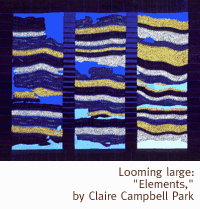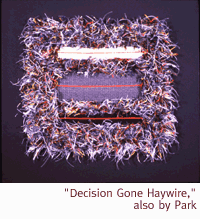

|

Claire Campbell Parks Rethinks The Use Of Fiber As Medium.
By Margaret Regan
IN THE HANDS of Claire Campbell Parks, the humble components
of cloth-linen wisps, cotton floss and metallic threads undergo
a transformation into art.
The internationally known weaver is exhibiting a modest suite
of just eight works at Obsidian Gallery, one of the city's best
repositories of fine crafts. But there's nothing at all modest
about Parks' aesthetic ambition. The Pima Community College professor
is a serious artist who's a master of color and a creator of complicated
compositions. Her gorgeously textured art just happens to be made
of fiber.
 "Celebration" is a case in point. A long, narrow weaving
that hangs horizontally, the piece has a series of seven bright
vertical bands heading east in no particular color order. On the
most visceral level, it's a giddy rejoicing in all the hues that
the artist has been able to muster, from navy to orange to cerulean
to yellow and blue. Its richly varied textures show off the combination
of weaving techniques that are a Parks trademark.
"Celebration" is a case in point. A long, narrow weaving
that hangs horizontally, the piece has a series of seven bright
vertical bands heading east in no particular color order. On the
most visceral level, it's a giddy rejoicing in all the hues that
the artist has been able to muster, from navy to orange to cerulean
to yellow and blue. Its richly varied textures show off the combination
of weaving techniques that are a Parks trademark.
The vertical bands are so tightly woven that a viewer can see
only the weft, not the warp. Gallery owner Elouise Rusk says this
taut technique is called a "rep weave." It allows for
strong color undiluted by opposing threads. But behind the brilliant
vertical bands is a weave of an altogether different character:
Loose and supple, these freewheeling background flosses snub tapestry's
traditional tidiness. At the left of the piece, they do make an
effort at order, obligingly organizing themselves into some subdued
stripes. But by the time they get halfway across the weaving,
they've allowed their stripes to dissolve into pure anarchy.
The contrast between the disciplined rep weaves and their anarchic
confreres is what makes this "Celebration" so delicious:
Like any weaving, it's about pleasing texture and color, but it's
also about clashing ideas of form.
 Two smaller pieces, "Decision" and "Decision Gone
Haywire," are also witty takes on ideas about art. "Decision"
has three tame bands of rep weave in subdued white, gray and black,
each crossed by a thin red line. All around them is a loose weave
in a cacophony of color so variegated it's like a paean to the
sewing basket overturned, emptied of flosses from yellow to green,
from blue to purple. "Decision" looks pretty darn footloose
until one proceeds to its companion piece, "Decision Gone
Haywire." This one is probably the very definition of weaving
revolution. The same well-behaved neutral stripes cross the center
of the piece, but all around them the colored flosses are engaged
in a weaving riot. Snipped free of their moorings at one end,
they've become wild, undulating strings. They stick so far out
from the background's flat surface that the piece becomes 3-D.
Two smaller pieces, "Decision" and "Decision Gone
Haywire," are also witty takes on ideas about art. "Decision"
has three tame bands of rep weave in subdued white, gray and black,
each crossed by a thin red line. All around them is a loose weave
in a cacophony of color so variegated it's like a paean to the
sewing basket overturned, emptied of flosses from yellow to green,
from blue to purple. "Decision" looks pretty darn footloose
until one proceeds to its companion piece, "Decision Gone
Haywire." This one is probably the very definition of weaving
revolution. The same well-behaved neutral stripes cross the center
of the piece, but all around them the colored flosses are engaged
in a weaving riot. Snipped free of their moorings at one end,
they've become wild, undulating strings. They stick so far out
from the background's flat surface that the piece becomes 3-D.
It's not surprising to find that the painterly Parks mats and
frames many of her works, just as though they were paintings.
A few weavings do hang unfettered on the wall, their central images
more conventionally framed by strips of woven cloth. Ironically,
these unframed weavings hint at figurative images more than the
framed works do. The wavy blue sedimentary layers in "Elements,"
shot through with metallic threads, suggest geologic rock or the
assorted depths of the sea. The lovely "Koi III," banded
in alluring shades of earth and olive green, is a wavy near-abstraction
punctuated by the organic orange shapes of the koi.
Parks has traveled and lectured around the world, and the various
national weaving traditions occasionally surface in her work.
As a Peace Corps worker in Morocco, Rusk says, Parks studied North
African weaving, and the delicate corner stripes in "Koi
III" seem to rise out of the Sahara. Likewise the serene
koi pieces look Asian, and Parks has indeed studied and lectured
in Japan.
Influences closer to home can be found in a group show at the
Tucson Pima Arts Council, Tapestries from the Southwest.
This large exhibition of 30 works by almost as many weavers (who
live in an arc from Texas to California) was juried by Rudy H.
Turk, former director of the University Art Museum at Arizona
State University. While nearly all the weavers here use standard
techniques that keep their threads flat and tamed, there is nevertheless
plenty of variation in their work. Mary Dieterich of Tempe uses
what looks like silk (the media aren't disclosed) to make a tiny
rendering of yellow and orange blossoms. Called "Line Dance,"
the delicate work has an Old World look about it, like a tapestry
found in a French or Belgian home. Conversely, R. Darden Bradshaw
of Tucson goes totally Southwest in "Out! To Sea," a
strangely desert-like tapestry rendered in thick purple yarns.
This is a funny piece of neo-photorealism unusual for weaving:
It pictures an aviator smiling outside his plane.
Robin Reider gives the nod to traditional tribal techniques in
her "African Sunset," a work in gold, brown and black
whose bold geometries seem more Navajo than African. (For a look
at authentic Navajo weaving, see First Nation: Fine Weavers,
continuing through March 14 at Tohono Chul Gallery.)
 A couple of the weavers come close to Parks' masterful aesthetic.
Marta Rogoyska of California has boldly distilled patio shapes
in her "Courtyard Series VII," and Phoenician Vera W.
Kopecek's "Blues" is a jazzy abstraction of pinks, oranges
and blues. Jane Hoffman of Alpine has turned her painterly impulse
into a detailed woven landscape of the White Mountains, complete
with blue-gray clouds, purple mountains and green canyons. It's
a work of astonishing virtuosity, but without the intellectual
subtleties of Parks' art in cloth.
A couple of the weavers come close to Parks' masterful aesthetic.
Marta Rogoyska of California has boldly distilled patio shapes
in her "Courtyard Series VII," and Phoenician Vera W.
Kopecek's "Blues" is a jazzy abstraction of pinks, oranges
and blues. Jane Hoffman of Alpine has turned her painterly impulse
into a detailed woven landscape of the White Mountains, complete
with blue-gray clouds, purple mountains and green canyons. It's
a work of astonishing virtuosity, but without the intellectual
subtleties of Parks' art in cloth.
Weavings by Claire Campbell Parks are on exhibit through
Saturday, March 20, at Obsidian Gallery in St. Philip's
Plaza, 4340 N. Campbell Ave. Gallery hours are 10 a.m. to 5:30
p.m. Monday through Saturday. For more information, call 577-3598.
Tapestries from the Southwest continues through
Friday, March 12, at the Tucson Pima Arts Council Community Gallery,
240 N. Stone Ave. Gallery hours are 8:30 a.m. to 5 p.m. Monday
through Friday. For more information, call 624-0595.

|
 |





